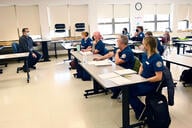You have /5 articles left.
Sign up for a free account or log in.
Food, housing and other forms of financial insecurity are a major reason behind students’ inability to complete community college.
A new report from the Center for Community College Student Engagement released during the 2017 Achieving the Dream conference today revealed that nearly half of community college students reported that a lack of finances could cause them to withdraw from their institutions.
“We can have all kinds of academic supports in place, but if we don’t come alongside them in this way also and help support them … it won’t matter how much else we do to prop them,” said Evelyn Waiwaiole, director of the center.
The annual CCCSE report surveyed nearly 100,000 community college students from 177 institutions and found nearly 4 in 10 receive federal Pell Grants. National data showed that nearly 61 percent of Pell recipients live below the poverty line. And of those who reported receiving Pell Grants, 40 percent say they rely on student loans, which may not be needed for tuition, to make ends meet.
Many of the students surveyed revealed they are living paycheck to paycheck, especially if they have dependent children.
The report also found:
- Six in 10 students reported they would have trouble getting $500 in cash or credit in order to meet an unexpected need within the next month.
- Those students receiving Pell Grants are more likely that those who don’t to aspire to an associate degree than a bachelor’s degree.
- Nine out of 10 surveyed students said they need information about financial assistance.
- Twenty-seven percent said the financial information they received from their college was inadequate.
- More than three-quarters of students report that they have the skills to manage their own finances, however, more than half report struggling to keep up with bills.
“This doesn’t look surprising given what we know about current trends in higher education,” said Katharine Broton, a researcher at the Wisconsin HOPE Lab and doctoral candidate in sociology at the University of Wisconsin at Madison. “This comes to the larger issue of college affordability … what we call the purchasing power of need-based financial aid has fall.”
The HOPE Lab is working with the Association of Community College Trustees to measure food and housing security in 75 community colleges.
In the 1970's, the typical Pell Grant covered the total cost of attendance, including tuition and living expenses, at community colleges across the country, Broton said, but that’s no longer the case as students are forced to find money elsewhere or cut back on expenses.
“Another part of this is that we know college students have limited access to the publicly-funded safety net,” she said. “They have to fit the criteria to be eligible for [food benefits] … finances are so tight for students we see them sacrificing adequate food or shelter while pursuing goals.”
The CCCSE study also revealed that 30 percent of students choose to stay enrolled in college in order to receive the financial aid.
“We have a lot of conversations that students are just trying to get the financial aid paycheck,” Waiwaiole said. “We talk about that as if it’s a terrible thing.”
If students have that high of need that they’re staying enrolled to receive the money, they must really need it, she said.
“There’s also a lot of embarrassment,” Waiwaiole said. “No one wants to say, ‘I’m needy.’ It’s a delicate conversation. It’s one that as institutions we need to identify these students and how do we come alongside them and help them to where a stigma is not associated with it.”
But many of these students reported that despite struggling to make ends meet, they can manage their own finances.
Waiwaiole said institutions have to be cognizant of how complex and “murky” the issue can be for students.
Broton said there are some things colleges can do in the short-term to help students who are struggling financially like by using emergency grant aid.
“That’s making a big difference in the lives of students, but it’s a short-term fix,” she said. “We need to be thinking about the total cost of attendance, not just tuition and fees. There’s been a lot of awareness and evidence that tuition and fees have been rising over time, but we need to be increasing awareness that the cost of living, transportation, child care costs and other things have been rising significantly over time as well and that’s a large share of the cost of college.”




